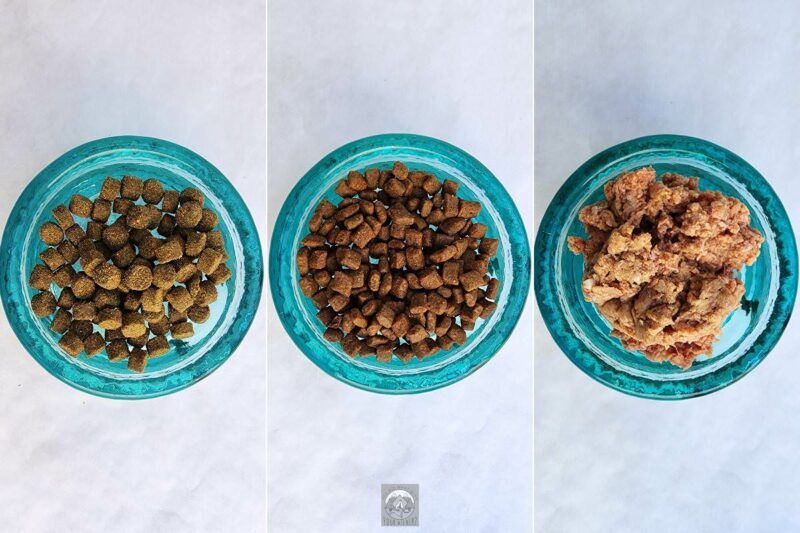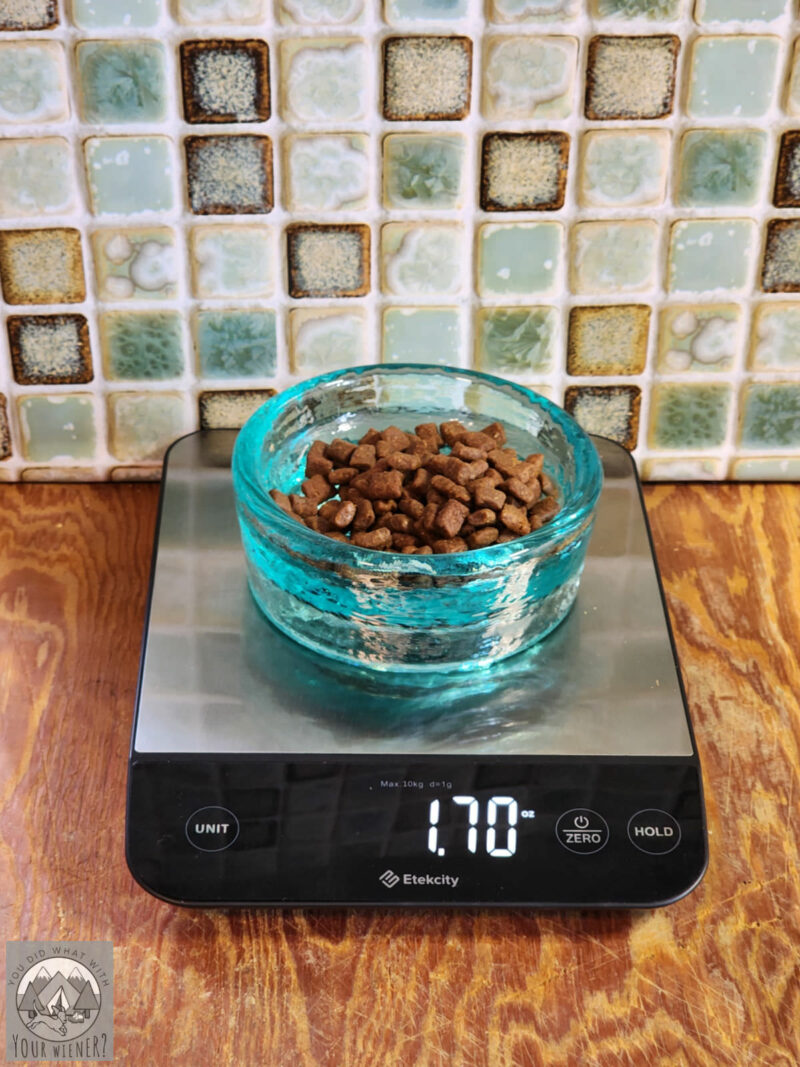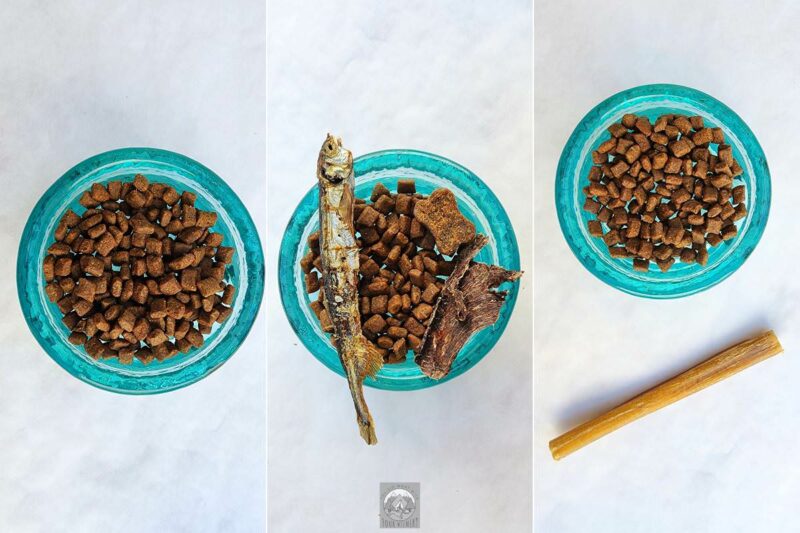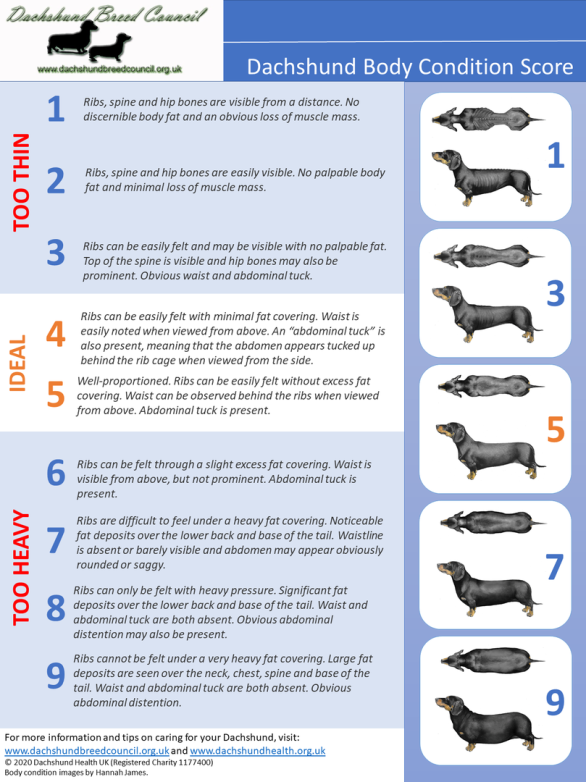How Much Should a Dachshund Eat?
The trite answer to the question of how much a Dachshund should eat is not so much that they become overweight and not so little that they become unhealthily skinny.
But you probably landed on this article because you want to know the actual amount your Dachshund should eat a day.
It is important to determine this on your own because each dog is different and the recommendations on the back of the food package are just that – recommendations.

What’s listed on the back of the package is an average. A typical starting place.
In this article, I will explain a couple different ways to determine how much food you should be giving your Dachshund a day.
Determining How Much to Feed Your Adult Dachshund
There are two primary ways to determine how much food a Dachshund should eat a day.
One, is the “eyeball” method. I explain this in more detail below.
I’m not just talking about “eyeballing” the amount of food you put in the bowl.
The other way is more accurate.
The more accurate way to determine how much food to give your Dachshund a day is to calculate the number of calories they need to consume.
Read on to understand each of these methods.
The “eyeball” method
This method is less accurate, and may result in a greater weight fluctuation over time, but it’s still an effective way to make sure that your Dachshund doesn’t become over or underweight.
More importantly, it takes little to no math to future out or special equipment. It’s simple.
For the eyeball method, the first thing to do is check the feeding guidelines on the back of your dog’s food package.

For dry dog food, the amount is typically listed in cups.
For canned it is often based on how much of the can to feed but may also list how many cups.
For raw food, the amount is typically listed in ounces, which you will have to weigh out on a scale.
Start feeding your dog this amount.
You may want to feed just under that amount if your dog is sedentary, spayed, or otherwise gains weight easily.
You may want to add just a little to that amount if your Dachshund is very active (typically, 30-60 minute walks at least 5 days a week).
Feed this amount to your dog for 4-5 weeks then check their body condition score according to the instructions further down the page.
You will then feed more, less, or the same, depending on your Dachshund’s body condition score.
Remember that this amount is the total amount of food per day.
You can choose to feed it all in one meal or in two.

The more accurate method
The most accurate way to make sure that your dog is getting enough food, but not too much, is to calculate the number of calories they need in a day.
This is true for whether the food is canned, kibble, or raw.
See my article with instructions for how to calculate your Dachshund’s calorie needs for more details.
Again, this amount of food is just a starting place.
However, since it is based on your own Dachshund, it will be a more accurate starting place.
Now that you have estimated your Dachshund’s daily calorie requirements, you want to make sure you are feeding them that amount – not significantly more or less.
Always check the calories listed on the back of the dog food package (note: kCal – kilocalorie – is the same as human calories) per unit of measurement and do some more math to figure out how many cups or ounces equals the number of calories your dog needs per day.
Then measure the appropriate volume of food using a cup or scale (I prefer a scale for accuracy).

You will still want to do the same as with the “eyeball method” – feed it for a month, check your Dachshund’s body condition score, then adjust up or down if needed.
Important: Don’t Forget to Account for Treats and Toppers
Whether you go by the recommendations on the back of the package or calculate the amount of calories, it’s very important to remember that is the total number for the day.
If your dog gets treats or chews throughout the day, or you add significant meal toppers or supplements to your Dachshund’s food, you will need to account for those calories too.
This is why I am a huge fan of one-calorie training treats.
Some treats list the calorie count on the back of the package. Many will not though.
Natural chews often do not.
For the ones that don’t list it, you can check the manufacturer’s website for that information or estimate the calories based on a human-food equivalent.
If you are using the eyeball method above, just guess about how much volume the treats and chews are and subtract a similar volume from the amount of food you are feeding your Dachshund a day.
For example, if you think you are giving your dog ¼ cup of treats a day, and the back of the food package says to feed your Dachshund ¾ cup a day, reduce the amount of kibble to only ½ cup a day to make up for the treats.
If you calculated the exact amount of calories, subtract the actual or estimated calories of all treats, chews, and meal toppers from the total.

Double Checking How Much to Feed Your Dachshund Using Body Condition Score
Regularly monitoring your Dachshund’s Body Condition Score (BCS) is the only true way to make sure that your Dachshund is at their optimum weight.
Here are the steps to determining your Dachshund’s BCS:
- Look at the chart below to familiarize yourself with what you will be looking for.
- Look at your dog’s ribs from the side while they are standing up. Can you see more than the last rib or two sticking out?
- If you can’t see your Dachshund’s ribs, try to feel them underneath the skin. Can you feel them but there is a slight to moderate fat covering or do you have to push hard to feel them?
- Look at your Dachshund from the side when they are standing up. Does their abdomen “tuck” up behind the ribs like a Greyhound or is their underside just one straight line from front to back?
- Look at your Dachshund from above when they are standing up (not while they are eating or drinking because some dogs suck their ribs in a little when doing this). Are their hip bones sticking out? Does your Dachshund have a waist (hourglass shape)?
Use your observations gathered from above and consult the Dachshund Body Condition Score chart below.

If your Dachshund is classified as underweight, their ideal weight may be 1-2 lbs heavier than their current weight.
If your dog’s BCS is above 5, you will likely want to reduce the amount of food you are feeding per day.
Read this article if you want to know how much a Dachshund should weigh
If your dog’s BCS is below 4, you may want to increase the amount.
Personally, I adjust up or down by ⅛ to ¼ cup of food per meal as needed.
If you are worried about reducing the amount of food so much that your dog will act like they are “starving”, read my article on helping a Dachshund lose weight.
Always consult with your veterinarian if you are not comfortable making this determination on your own.
Note: you may actually want to check your Dachshund’s BCS before you start calculating how much to feed them since you may feed a little more or less depending on their current BCS score.
How Much to Feed a Dachshund Puppy
The calculations above are for an adult Dachshund, so you may be asking yourself, “How much should I feed my Dachshund puppy?”
Puppies need to be fed a larger amount of food more frequently than adults because they are still growing.
Furthermore, small breed puppies like Dachshunds tend to grow more quickly and have a faster metabolism compared to larger breeds.
They also require a different nutrient profile than adults do.
Your Dachshund puppy should be eating high-quality food with at least 22.5% protein content.
How much food your Dachshund puppy should eat
Using the “eyeball” method described above, based on the food recommendation listed on the back of the puppy food bag, is probably the most accurate way to feed a puppy.
Calculating calories is hard because a puppy grows so fast that their weight (the primary measure calorie needs are based off of) is constantly changing.
It can even change daily!
Most puppy foods will make the recommendations on the chart below. As you see, there is quite a range!
That’s why it’s best to go with what is listed on the back of the package for a specific puppy food.
Below is a general Dachshund puppy feeding chart.
| Ideal Weight | 3-5 months | 6-8 months | 9-11 months | 1-2 years |
| 3-12 lbs | 3/4 – 1 1/3 cup | 1/2 – 1 1/2 cup | adult portion | adult portion |
| 13-20 lbs | 1 – 2 cups | 3/4 – 1 1/2 cup | 1 – 1 1/2 cup | adult portion |
How many times a day should a Dachshund puppy eat
Dachshund puppies should be consuming 3-4 meals per day so divide that daily amount into equal portions for each meal.
For Dachshund puppies, follow this rough feeding guideline:
- 2-4 months old: 4 meals daily
- 4-6 months old: 3 meals daily
- 6-8 months old: 2-3 meals daily
- Over 8 months old: 2 meals daily
Body Condition score Matters, but not as much
Verifying that your puppy is not getting too skinny or plump using the Body Condition Score (BCS) chart is still relevant but not as much while they are growing.
Like human kids, based on my observations, Dachshund puppies typically grow “out” before they grow “up”.
This means that they may get a little roly-poly before the next growth spurt when they will grow longer and taller.
In my opinion, a puppy’s ideal BCS is between 5 and 7. I am not a vet though, just a passionate Dachshund owner.
Still, it will be clear if your puppy is too skinny (body condition score of 2 or 1).
Monitor your puppy’s body condition and adjust portion sizes as needed.
For the most accurate advice, consult your veterinarian, who can provide you with specific types of food, supplements, and feeding schedules tailored to your puppy’s needs.
Final Thoughts
There is no absolute, hard and fast rule about how much a Dachshund should eat per day.
There are so many variables to consider like the calorie density of the food, your Dachshund’s ideal weight, their age, whether they are spayed and neutered, and how active they are.
Learning the proper amount you should be feeding your Dachshund is the first step to a long, happy, comfortable life for them.
However, food is not just something you can “set and go”.
You will want to revisit the amount of food you give your Dachshund several times throughout their lifetime, if not several times a year.
Times you may need to recalculate the amount are:
- When your Dachshund transitions from a puppy to an adult
- When your Dachshund is spayed or neutered
- When their activity level changes – significantly increased or decreased
- If they develop health issues requiring medication
- If you switch the food type or brand
- When on crate rest and recovering from IVDD
The #1 foolproof way to make sure you are feeding your Dachshund the right amount of food each day is to closely monitor their Body Condition Score (BCS).
That will help guide your decision to increase or decrease the amount of food your Dachshund eats.
And, speaking of food, you might be wondering what the best food for a Dachshund is.
The truth is, there are a lot of great foods out there and, personally, I like to rotate (change) my Dachshund’s food often to keep it interested and to help their gut be more resilient.
Read this article to see what I feed my miniature Dachshunds.


About the Author
Hi, I’m Jessica. I’ve been studying the Dachshund breed since 2007, owned 3 of my own, and shared in the lives of thousands of others through their owner’s stories. When I’m not sharing what I know on this blog, you can find me hiking, camping, and traveling with my adventurous wiener dogs.
